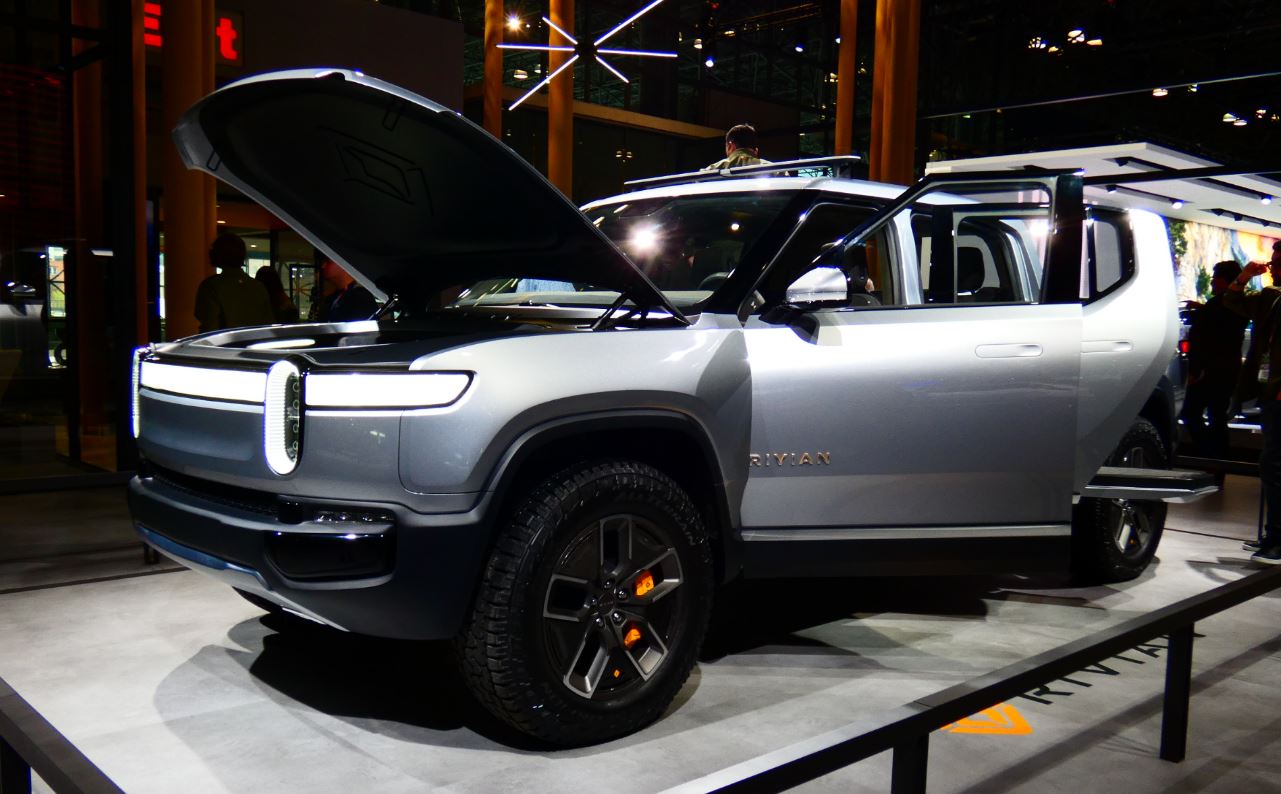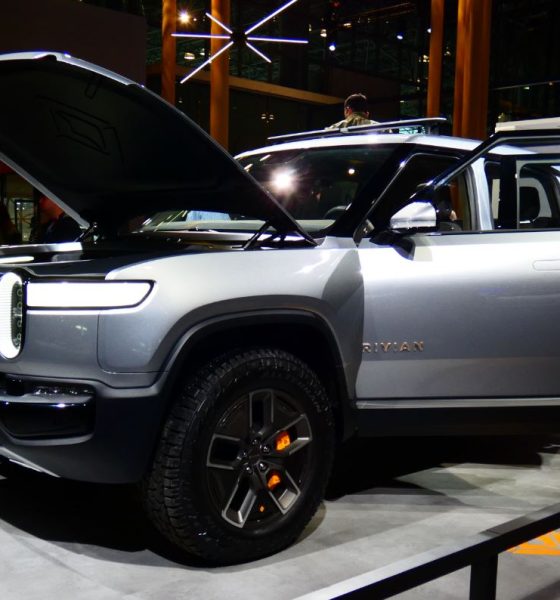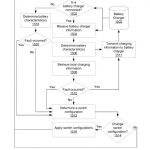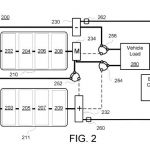

News
Rivian patent application hints at 900V fast charging capabilities
A recently published Rivian patent application titled “Configurable Battery Pack for Fast Charge” describes a method of switching between battery pack connection types to allow for both 450V and 900V fast charging without the need for specialized components. The invention was filed in both the US and internationally, and both applications just published today as US Patent Publication No. 2019/0126761 A1 and International Publication No. WO/2019/084507 A1.
Rivian’s application sets out to solve three specific issues with electric vehicle battery charging. First, increases in charging rates typically require more expensive parts that are rated for the higher current requirements. Second, electronic devices operated while a battery is charging may be impacted via increased voltage when a battery’s charging rate is increased. Finally, when a fault occurs in a battery module, a battery system often needs to be completely disconnected from any loads or the charging voltage must be changed.
The basic concept of the application purports to solve the above-referenced problems. As described, the invention claims that battery modules connected in parallel achieve a targeted maximum high voltage for an electric load (such as 450V), but when connected in series that voltage can be doubled (900V). Details of why this is advantageous are explained in the application as follows:
“A configurable battery system allows the techniques of [this invention] to be applied to an electric vehicle…to more fully utilize a battery charger’s potential [where] it is desirable to achieve a particular charging target. For example, a charging target of 150 kW at 450 V may require a current of 334 A…[and] components may need to be sourced to handle up to 400 A continuously to handle the charging….If a battery system were able to take advantage of charging at 900 V, the charging target of 150 kW could be achieved at just 167 A, which may allow for more numerous, better quality, or cheaper options for charging components. For example, a current of 167 A may allow different hardware to be used than if the current were nearer to 400 A.“
- Figure from Rivian’s battery connection switching patent application. | Image: Rivian/USPTO
- Figure from Rivian’s battery connection switching patent application. | Image: Rivian/USPTO
- Figure from Rivian’s battery connection switching patent application. | Image: Rivian/USPTO
The application also includes a battery management system to determine which connection should be used at a given point and switch the connection type accordingly. This same management system is also used to detect faults in the system while charging and use the switching capability to handle them accordingly rather than disconnecting any battery loads.
The US application for this invention was filed June 8, 2018 and thus has not yet been examined. However, in the international version, an examiner has already searched for related inventions based on the first 10 claims of Rivian’s application. These claims only describe “a configurable battery system in which connection of two batteries can be switched between a series and a parallel connection”, which is not considered novel on its own.
This kind of finding is not uncommon for applications undergoing the international filing process and will be further addressed once filed in specific countries. Three other inventions were determined to be present in the application which will likely be incorporated with the first ten as the invention’s proceedings continue.

Rivian aims to be the leading expert on battery technology, and patent applications such as this one are a nod towards that innovation goal. The Michigan-based all-electric car maker runs a battery lab in Irvine, California where it has picked up several engineers from renowned supercar brand McLaren. This talent pool includes hypercar engineer Richard Farquhar who is their VP of Propulsion, leading Rivian’s battery and powertrain development.
Currently, each Rivian battery module holds 864 cells, stacked evenly on top of one another, with a thin 7mm aluminum plate with liquid coolant in between. In addition to connection testing, the company uses machine learning to adjust battery cell settings to build predictive models and tune the cells based on situations that may be encountered, such as weather conditions.
Altogether, Rivian’s aim to achieve a level of battery technology that’s reliable and optimal for the electric outdoor adventure branding it has embraced looks to be moving in a promising direction.

Elon Musk
Elon Musk and Tesla AI Director share insights after empty driver seat Robotaxi rides
The executives’ unoccupied tests hint at the rapid progress of Tesla’s unsupervised Robotaxi efforts.

Tesla CEO Elon Musk and AI Director Ashok Elluswamy celebrated Christmas Eve by sharing personal experiences with Robotaxi vehicles that had no safety monitor or occupant in the driver’s seat. Musk described the system’s “perfect driving” around Austin, while Elluswamy posted video from the back seat, calling it “an amazing experience.”
The executives’ unoccupied tests hint at the rapid progress of Tesla’s unsupervised Robotaxi efforts.
Elon and Ashok’s firsthand Robotaxi insights
Prior to Musk and the Tesla AI Director’s posts, sightings of unmanned Teslas navigating public roads were widely shared on social media. One such vehicle was spotted in Austin, Texas, which Elon Musk acknowleged by stating that “Testing is underway with no occupants in the car.”
Based on his Christmas Eve post, Musk seemed to have tested an unmanned Tesla himself. “A Tesla with no safety monitor in the car and me sitting in the passenger seat took me all around Austin on Sunday with perfect driving,” Musk wrote in his post.
Elluswamy responded with a 2-minute video showing himself in the rear of an unmanned Tesla. The video featured the vehicle’s empty front seats, as well as its smooth handling through real-world traffic. He captioned his video with the words, “It’s an amazing experience!”
Towards Unsupervised operations
During an xAI Hackathon earlier this month, Elon Musk mentioned that Tesla owed be removing Safety Monitors from its Robotaxis in Austin in just three weeks. “Unsupervised is pretty much solved at this point. So there will be Tesla Robotaxis operating in Austin with no one in them. Not even anyone in the passenger seat in about three weeks,” he said. Musk echoed similar estimates at the 2025 Annual Shareholder Meeting and the Q3 2025 earnings call.
Considering the insights that were posted Musk and Elluswamy, it does appear that Tesla is working hard towards operating its Robotaxis with no safety monitors. This is quite impressive considering that the service was launched just earlier this year.
Elon Musk
Starlink passes 9 million active customers just weeks after hitting 8 million
The milestone highlights the accelerating growth of Starlink, which has now been adding over 20,000 new users per day.

SpaceX’s Starlink satellite internet service has continued its rapid global expansion, surpassing 9 million active customers just weeks after crossing the 8 million mark.
The milestone highlights the accelerating growth of Starlink, which has now been adding over 20,000 new users per day.
9 million customers
In a post on X, SpaceX stated that Starlink now serves over 9 million active users across 155 countries, territories, and markets. The company reached 8 million customers in early November, meaning it added roughly 1 million subscribers in under seven weeks, or about 21,275 new users on average per day.
“Starlink is connecting more than 9M active customers with high-speed internet across 155 countries, territories, and many other markets,” Starlink wrote in a post on its official X account. SpaceX President Gwynne Shotwell also celebrated the milestone on X. “A huge thank you to all of our customers and congrats to the Starlink team for such an incredible product,” she wrote.
That growth rate reflects both rising demand for broadband in underserved regions and Starlink’s expanding satellite constellation, which now includes more than 9,000 low-Earth-orbit satellites designed to deliver high-speed, low-latency internet worldwide.
Starlink’s momentum
Starlink’s momentum has been building up. SpaceX reported 4.6 million Starlink customers in December 2024, followed by 7 million by August 2025, and 8 million customers in November. Independent data also suggests Starlink usage is rising sharply, with Cloudflare reporting that global web traffic from Starlink users more than doubled in 2025, as noted in an Insider report.
Starlink’s momentum is increasingly tied to SpaceX’s broader financial outlook. Elon Musk has said the satellite network is “by far” the company’s largest revenue driver, and reports suggest SpaceX may be positioning itself for an initial public offering as soon as next year, with valuations estimated as high as $1.5 trillion. Musk has also suggested in the past that Starlink could have its own IPO in the future.
News
NVIDIA Director of Robotics: Tesla FSD v14 is the first AI to pass the “Physical Turing Test”
After testing FSD v14, Fan stated that his experience with FSD felt magical at first, but it soon started to feel like a routine.

NVIDIA Director of Robotics Jim Fan has praised Tesla’s Full Self-Driving (Supervised) v14 as the first AI to pass what he described as a “Physical Turing Test.”
After testing FSD v14, Fan stated that his experience with FSD felt magical at first, but it soon started to feel like a routine. And just like smartphones today, removing it now would “actively hurt.”
Jim Fan’s hands-on FSD v14 impressions
Fan, a leading researcher in embodied AI who is currently solving Physical AI at NVIDIA and spearheading the company’s Project GR00T initiative, noted that he actually was late to the Tesla game. He was, however, one of the first to try out FSD v14.
“I was very late to own a Tesla but among the earliest to try out FSD v14. It’s perhaps the first time I experience an AI that passes the Physical Turing Test: after a long day at work, you press a button, lay back, and couldn’t tell if a neural net or a human drove you home,” Fan wrote in a post on X.
Fan added: “Despite knowing exactly how robot learning works, I still find it magical watching the steering wheel turn by itself. First it feels surreal, next it becomes routine. Then, like the smartphone, taking it away actively hurts. This is how humanity gets rewired and glued to god-like technologies.”
The Physical Turing Test
The original Turing Test was conceived by Alan Turing in 1950, and it was aimed at determining if a machine could exhibit behavior that is equivalent to or indistinguishable from a human. By focusing on text-based conversations, the original Turing Test set a high bar for natural language processing and machine learning.
This test has been passed by today’s large language models. However, the capability to converse in a humanlike manner is a completely different challenge from performing real-world problem-solving or physical interactions. Thus, Fan introduced the Physical Turing Test, which challenges AI systems to demonstrate intelligence through physical actions.
Based on Fan’s comments, Tesla has demonstrated these intelligent physical actions with FSD v14. Elon Musk agreed with the NVIDIA executive, stating in a post on X that with FSD v14, “you can sense the sentience maturing.” Musk also praised Tesla AI, calling it the best “real-world AI” today.











